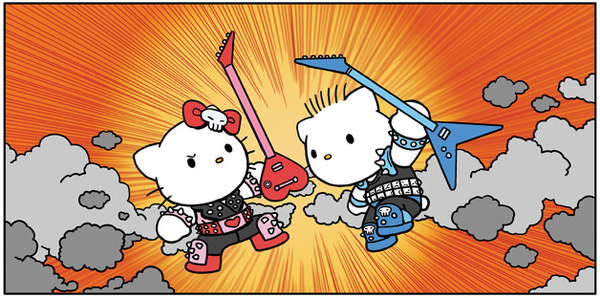Read This: Hello 40

Jorge Monlongo
I can spot at least eight different Hello Kitty dolls in this apartment without actually looking for them; it’s safe to say the fandom here runs pretty deep. So I was genuinely excited as soon as I learned about Hello 40, a multi-artist tribute to the character that has practically become the very definition of “iconic” over the last four decades.
There are some common themes running through many of the two- and three-page stories; parties (sometimes surprise parties!) play a recurring role, and several other stories are framed as dreams (including a story by Karl Kerschl that has its mindblowing conclusion truncated). There are a few hints of scary moments, but by the end of each story everything’s been sorted out and more often than not new friends have been made; my favorite moment along those lines is in Brianne Drouhard’s “Marshmallows,” where Hello Kitty storms a castle and comes face to face with a feverish dragon, who helps them roast marshmallows indoors.
Some artists render Hello Kitty and her friends almost exactly like the Sanrio versions, while others take a slightly freer illustrative hand, with almost an indie comics vibe in a few cases—and I love the middle ground that all-ages comics artists like Art Baltazar and Chris Giarrusso take in their contributions. And there are nearly painterly approaches, like Drouhard’s or Martin Hsu’s “Once Upon a Hello Kitty Wedding,” that are gorgeous. This is a book that should be equally enjoyable for those of us who are roughly the same age as Hello Kitty simply reveling in the artwork on our own, or sharing the stories with much younger fans… or future fans!

Karl Kerschl
21 December 2014 | read this |
A Dystopia That Wasn’t
“Can you write about the future these days without it being apocalyptic?†Jason Heller wondered after reading Monica Byrne’s The Girl in the Road. Of course, you can, and people do, but in a very particular intersection of “literary fiction†and “science fiction,†the books that have gotten the most attention are dystopian. It isn’t that surprising, when we think about it: dystopian futures are defined by adversity, adversity creates challenge, and challenge generates drama. Where’s the dramatic tension in a world where everything’s worked out fine and we’ve all gotten everything we want, right? (At least, that’s how the easy logic works.)
Byrne sets her novel in a late 21st century that’s far from comfortable but, apart from an implied sea level rising due to global warming, isn’t all that much more dystopian than the world of 2014. The balance of political and cultural power may have shifted (“Africa is the new India, after India became the new Americaâ€), but the violent factionalism of Byrne’s world is indistinguishable from our own. The true crises in the novel are interior, emotional. When we first meet Meena, one of the novel’s two central characters, she’s fleeing from her apartment in Kerala and, believing that a terrorist organization is hunting her down, tries to kill herself by jumping in front of an oncoming train. After she’s rescued, she decides to head to Mumbai and, from there, makes plans to cross the Arabian Sea on foot to her Ethiopian homeland. That’s not as impossible as it sounds, because there’s a long string of hydrogen superconductors stretched out across the water, collecting energy; that said, it’s illegal and highly dangerous, and the journey will exacerbate Meena’s already unbalanced emotional state.
The novel’s other narrative thread focuses on Mariama, an escaped slave who meets some friendly caravan drivers and joins them on a trek across Africa, approaching Ethiopia from the opposite direction as Meena. Looking back at this journey from the perspective of her childhood, Mariama’s perspective is limited, and her experiences traumatize her in ways that she can recognize but not necessarily articulate clearly, even to herself. From the very beginning, Byrne hints that there’s a connection between her story and Meena’s, and you’ll likely be able to figure out just how the two arcs will intersect some time before both women’s lives spiral towards their unsettling climaxes.
Climaxes which, to circle back to my initial point, ultimately don’t rely upon the novel’s “dystopian†features for their narrative momentum. The setting is less important here than the emotional dynamics, and those dynamics could just as easily play out in contemporary settings. In that sense, then, The Girl in the Road is not a post-apocalyptic novel at all, but a contemporary drama with just enough futuristic flourishes that it can straddle the line between mainstream fiction and science fiction.
(more…)
10 September 2014 | read this |

 Our Endless and Proper Work is my new book with Belt Publishing about starting (and sticking to) a productive writing practice.
Our Endless and Proper Work is my new book with Belt Publishing about starting (and sticking to) a productive writing practice. 
